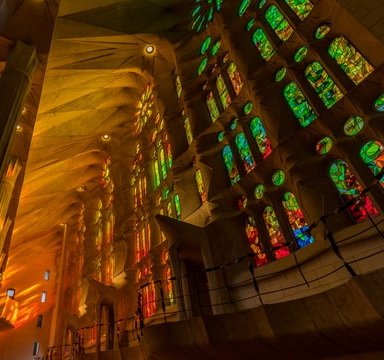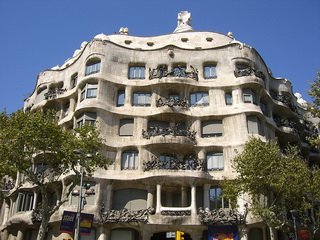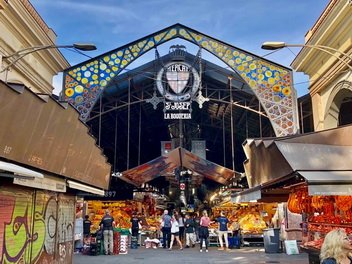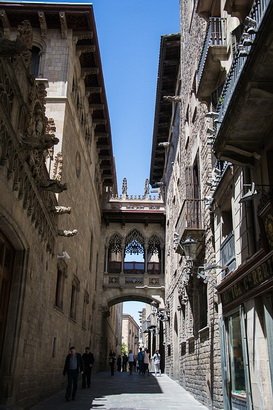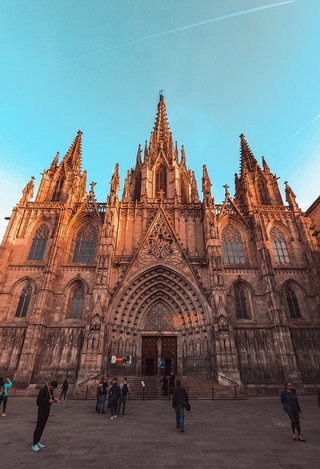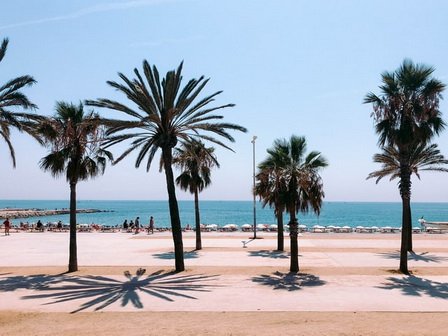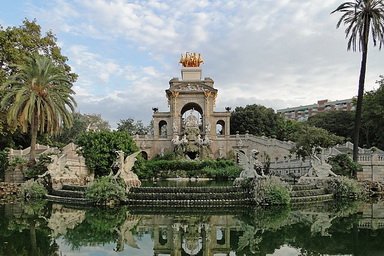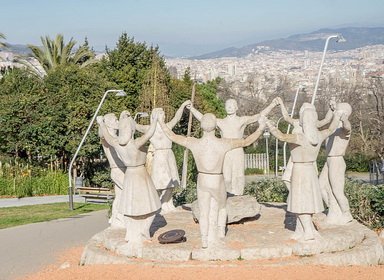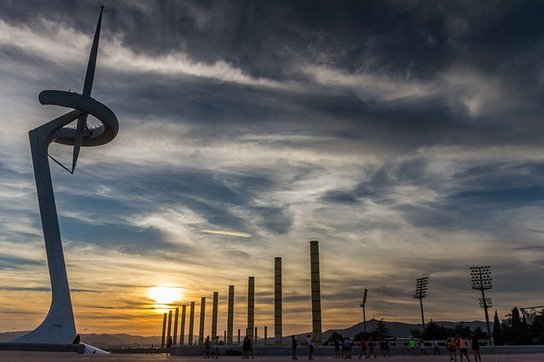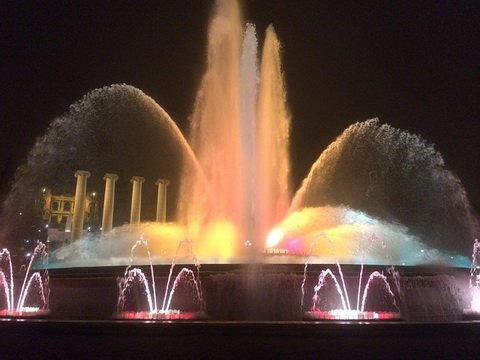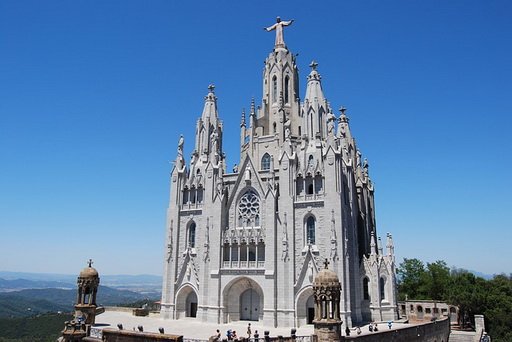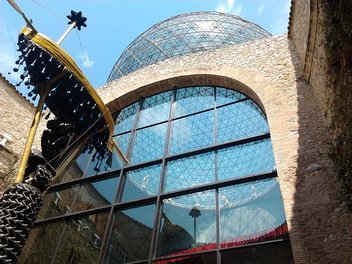Main attractions
View on the map
Sea and mountains
8 The port area – 9 The beaches and Barceloneta – 10 Park de Ciutadela – 11 Montjüic – 12 Magic Fountains
1 Sagrada Famiglia
How to describe it only in this small passage – it is impossible… The same adjective can be the core word used with the Church of the Holy Family. Yes – medieval cathedrals were built for hundreds of years. But this, now a basilica (Pope Benedict consecrated it recently), was started to be built merely in 1883. It has already surpassed the old models.
It was supposed to be a gothic structure. But architects had to be changed and Antonio Gaudi took over. It was he who added the neo- and surrealistic touch to each element of it. It was his life’s work – you can read about it in the adjacent museum.
Every side of it, every element on and in it seems different from the other one. It is not a church – it is an artistic masterpiece. A mixture of nature, formed by a man into shapes that emerge from the stone as if they were always there.
The majestic interior gives you the impression of being in some mystic, holy temple made by forgotten giants. It looks like it is alive, breathing with the sun moving through the sky and illuminating the multifaceted stained glass.
It is a marvel that it is still being constructed. It went through wars, the death of Gaudi, the destruction of original plans and sketches, and some demolishing ideas. The genius of technology and the stubbornness of a man will make the dream come true and finished… hopefully quite soon. It was supposed to happen in 2026 but it is already rescheduled.
See the progress by yourself while you still can. What you will pay for the ticket will become the last spire or s sculpture, since this is how the construction is financed. Walk around it, see all the wonderful naves, try to count the towers, breathe the colors of the interior and go to the museum to see how the 3D machines help to create this wonder.
2 Park Guell
At the beginning of the XX century, the pine forests and olive groves of the northern slopes of Barcelona were turned into a 17-hectare park. Antonio Gaudi was responsible for the design, and he created a colorful, calm and cheerful, UNESCO site.
As with all the works of this architect, you can see the harmonious interactions with nature. The grottoes and the arches look like they have always been there. The fountains and staircases are a pleasure for the eye.
And the surrealistic parts are also mesmerizing with colors. Benches are the waves of the sea covered by the mosaic forming strange patterns. The buildings look like mountains covered by white snow of a roof (the museum is here). The iconic lizard is guarding them.
It is a great picnic spot and a walking area, and it offers great views of the city and the sea.
3 Other Gaudi
Antonio Gaudi worked on various projects in the city. He took part in the creation of some residential areas. One of his buildings is called La Pedrera (Casa Milà) and is in the Eixample district, close to Passeig de Gracia.
The name translates to “the stone quarry” and it is easy to understand why. When you look at the grey exterior you may have a feeling it is an open quarry. The waves and curves of the stone open to the holes where it was taken from. These are the windows and the balconies. The metal railings are intricate and in different plant-like shapes. They look like vines covering the stones.
The entrance to the building leads through an artistic iron gate. The inner courtyard houses the Fundacio Catalunya – they organize the Catalan, cultural events.
It is an engineering marvel that is self-ventilating. The ribbed arches bear the weight of the construction, although they look so fragile. You cannot see it, as you cannot really see that there actually are chimneys on the roof (not from the street level at least). Gaudi gave them all a special form. It all made the roof look like a part of the quarry – as natural as every other aspect of building.
Casa Battló is on the UNESCO list as is the building mentioned above. It was designed as a private residence for a textile manufacturer. The façade seems more spectacular, with intricate shapes and ornaments and mosaic colors. It is a dreamlike fairy castle coming true. “Plants” are covering it, balconies look like faces of some guardians and the roof is in the shape and colour of the sea waves.
The interior is even more surreal and there is a 10D experience which may give you a scope into Gaudi’s mind. Although the interior itself is fascinating and you will want to stay on the Noble Floor forever.
4 La Rambla
You are bound to find it. This 1.2-kilometer line connects the Catalonian Square with the port, to be more specific – with the Columbus Monument. It marks the western end of the Gothic Quarter making her a great start or end of your journey through this maze of the streets.
La Rambla itself is a sightseeing spot. You can have a lovely walk in the shade of the trees or… In the season there are two separate lines of small shops where you can buy things, have a picture painted and more. The prices may be challenging, so be careful. The street performances will amaze you – the living statues are extraordinary (our personal favorite is the Alien).
Be wise and remember – watch out for pickpockets.
On your way there, you will catch a glimpse of a market called La Boqueria. The huge iron-glass entrance sticks out among the stone facades of the neighboring tenements. It may be nothing more than a place for the locals to buy meat and vegetables, but for the tourists – it is packed with the curiosities of Catalonia.
You must visit and see the butcheries with aromatic Spanish ham, the shelves heavy with colorful fruit, fridges with cheese varying from white to yellow and orange. If you are looking for an edible souvenir – this is the place to be: cheese, ham, olives, spices, virgin oil, sweets like touron – everything you can dream of! If you are looking for lunch – you will be soooo happy. And if you are looking for just a bite – come in! Try the ice-cold watermelon or fruit cups. There is even fresh coconut!
5 Catalonian Square area
One of the ends of La Rambla street is marked by Plaça de Catalunya, where you will also find a 12th-century Convent of Santa Anna. But the Arms of the star lead you in other directions as well.
Passeig de Gracia may be the main point of this area. It is sometimes called the Elysium Fields of Barcelona, and probably for the same reasons. The area is splendid, full of great (and expensive) shops and restaurants. It goes right through the Eixample District, where the straight-angle streets start to appear. The new Barcelona’s urban plan started here.
If you follow the Passeig you will go through the famous Quadrat d’Or – which is a special district full of modern buildings inspired by the works of Antonio Gaudi. It is a work of different architects, and it is full of delightful surprises around every corner. Students of architecture will spend here their whole visit to Barcelona! Two special jewels there were both made by Gaudi himself (read above).
Close by, at the end of Via Laietana (another road leading from Catalonian Square to the port) is the Palau de la Musica Catalana. It is a concert hall (on the photo) built at the beginning of the XX century. It is built in the majestic style of Art Nouveau which earned it a place on the UNESCO list. The mosaics create paintings and adorn architectural elements like columns. Sculptures stand high and the ironwork is exquisite. And this is only the front of the building that you are seeing. The interiors are even more breathtaking.
6 Barri Gòtic
For many, the visit to the maze of the Gothic Quarter is the highlight of their visit to Barcelona. The medieval, historical landmarks are dominant in the area, but you will see here also much older things. This is where the Romans founded their city! The straight lines of the streets going from Plaça Reial in every direction are the proof of it even if they disappear into the maze of the gothic passages. There is no more roman forum there, but the square is one of the loveliest places in the area.
The order vanishes quickly and turns into the narrow passages, hidden places, and buildings so close to each other that you could have made a high five with your neighbor. The cobbled alleys are home to restaurants and tapas bars. There is also a lot of tourist shops with every souvenir you can think of.
There are galleries and museums – the History of Barcelona Museum is one of the most important. Not only for its artifacts but also because it is located in a beautiful, XVI century villa – Casa de Padellas. Some of the architectural wonders here include the remains of the Roman town, bridges interlinking the buildings above the heads of the pedestrians, and of course – the Cathedral of Barcelona.
Via Laietana is a part of it all and it divides the area into two sections. It is a welcomed break area where you can shop and eat or simply – follow a straight road to the next place you want to visit. On its one end is the port, as with the example of La Rambla, the other end is the Catalan Square and La Gracia area. Crossing this street will take you to La Ribera where you will find the Picasso Museum and the stunning basilica of Santa Maria del Mar. If you love the gothic style and the details of 15th century-stained glass – it is an obligatory attraction for you. It is also calmer and more serene than her counterpart at the Nova Square.
7 Cathedral of Saint Eulalia
The steep hill of Monte Táber (17m high) was home to the roman Barcino. You do not feel it today, wandering around Barri Gòtic, but there it is or rather… was. Its heart was in the Middle Ages and today is the Cathedral of Barcelona. She may not be as spectacular as another notable church in this city, but the locals love it. Direct yourself to Nova Square and have a look.
The majestic, gothic building is not as imposing as other churches of this significance. You follow the cobbled paths of the old quarter; you go out into a square and there it is. Every architectural detail trying to reach the sky.
In the shadows of its walls, the most precious people of the city found their resting place. One of them is count Ramon Berenguer I who is responsible for the first draft of the city’s constitution (Usatges de Barcelona).
But the most important is Eulalia. A young girl, crucified by the Romans at the tender age of 13. She is the Saint and Protectress of the city. The cathedral has an adjacent cloister which you can visit. Until today white geese live there. They represent the pure soul of Saint Eulalia and something more. Want to know – count them.
Just a note – on weekends (tourist season), you can see the Sardana Dance on the square in front of the church.
8 Port area
People come here for one important reason – to relax! The port may have 2000-year history, it may be one of the largest ports of Spain and more. But it also has beautiful marinas, full of yachts with white sails.
Rambla de Mar – a quay adorned by artificial waves is in fact mobile. You can take great pictures there, but when a boat wants to cross – no passage. Do not worry – Maremagnum Mall and the Aquarium will make your time there worthwhile. And it is not that you are stranded on an island – you can go back to Via Laietana through the Ictineo Square. There is a Museum of Catalonian History not far from here. From there it is only a short walk to Barceloneta, the beach, and the Teleferic del Port, which will take you to Montjüc in the red cable car.
The Monument of Christopher Columbus stands in the vicinity. The sailor looks one way but points to the other. Maybe he followed La Rambla for his meeting with Queen Isabela and King Ferdinand? Maybe you are walking where he once did.
For those who want to know more about the area – visit the Maritim Museum. The building itself is stunning – these were once the Royal Shipyards. The place goes back to medieval times and the knowledge inside will tell you more about the Catalan Maritime Empire.
9 San Sebastian Beach & Barceloneta
One of the beaches of Barcelona is called San Sebastiàn, after a village that was here. If you start walking north, you will eventually get to Llevant (a few kilometers walk). On a hot, Spanish day, you cannot see the sand and the sea brings the energy that everyone is searching for. It is close to the city, there is a wide variety of activities you can do there, bars, benches to sit and read, and more.
Just next to it is the Barceloneta – a neighborhood that started as a home of workers. The beginnings can be traced to an island of Maianas in the XVII century… you would never imagine it walking the charming streets in search of a restaurant. It is a great place to eat, there is a variety of cuisines to choose from, nice places for shopping and what is the most important – it is just next to the beach.
10 Parc de Ciutadela
If you look for a quiet place in the city go to Ciutadella Park. The dark days of king Philip V conquering Barcelona in 1714 cannot be seen in this green oasis. But the name reminds us of the story.
The Park was created for the Universal Exposition of 1888. There is a zoo, a lake, a Museum of Science and a Triumphal Arch. You can rent a rowboat and relax or go for a stroll in the alleys overshadowed by trees and hiding old citadel buildings. Find the waterfall where Gaudi worked as a student, bring a ball, and have some fun or climb to a small temple for some views. Maybe you will even spot a mammoth!
Arc de Triomf was the main gate to the 1888 Fair. Just follow the promenade leading out of the park to find it. It is a proud example of Catalan-Mudejar style, with some interesting friezes (like the front one – “Barcelona welcomes the nations” – very appropriate even in the XXI century). It has a very distinctive red color. You will love it – it makes Barcelona even more eclectic than it already is.
11 Montjüic
The mountain protecting Barcelona was a strategic location for centuries. It received her name in medieval times because a Jewish cemetery was founded here. A similar story and a name can be found in Girona. But this particular hill is home to things that cannot be found anywhere else in the world.
The top (213 meters) is crowned by a fortress. The first stone was laid here in the XVII century. This fortified place had only one purpose – control the citizens. A year after its creation the regiment saw their first battle as a Catalan revolt soon erupted. Later the castle changed the governing hands a lot, grew, served different purposes. Today it is a Military Museum with splendid views of the city. Teleferic de Montjüic (not “the Port”) goes straight to it, so there is no need to climb.
Unless you want it! Montjüic has wonderful gardens (e.g. Laribal Gardens have a lovely waterfall) or even better – the Botanical Gardens (visit with payment). There are plenty of paths and roads offering staggering views of the city. They lead to some places of interest too. Fondation Miró is one of them. The artist opened it and today it houses over 100 thousand of his works (paintings, sculptures, tapestries, drawings, etc). The building itself is an example of contemporary art (designer – Josep Lluis Stert) and the events hosted here are one of a kind.
The hill was also a venue for the Summer Olympics of 1992. The stadium is open and free to visit for all tourists. Next to it is Palau Sant Jordi – the sports hall. In yet another building – the Olympic and Sports Museum. Another recognizable landmark of this place is the Torre de Comunicacions. Its white shape looks like an alien starship waiting to launch and fly away (on the photo).
Last but not least is the imposing building of MNAC – an art museum. Its monumental stairs lead to the fountains where you can see the greatest show of Barcelona (see below).
12 Magic Fountains area
There can be no visit to Barcelona without the magical night of the dancing fountains.
Direct yourself to Pl.Espanya and follow the Av.de la Reina Maria Cristina. The show lasts for a few hours with 10-15 minute sessions every half an hour. It is a spectacle of light, music, and water-dance – it is recommended to admire it at night. In the tourist season, you can come here every evening from Thursday to Sunday. Off-season you have only Friday and Saturday sessions.
If you arrive too early don’t worry. Fountains were constructed for the 1929 International Exhibition. It took place in here, and there is a lot of remnants of those time.
The first thing you will notice is the imposing building on the hill. It is the Museu Nacional d’Art de Catalunya (called MNAC) – Romanesque art is represented exceptionally well, but there is much more. The building looks like a baroque palace of the great kings. A huge staircase has a fountain in the middle. The steps lead you to the terraces from where you can explore the green areas of the Montjuic hillside. They are also a good vantage point for the spectacle.
Secondly, a bit to the side is the Caixa Forum. It is an art gallery/event hall situated in a renovated textile factory. Pass it, follow the Av. Francesc Ferrer I Guàrdia and arrive at Poble Espagnol. It is an open-air museum also from the times of the Exposition. The great thing about it is that it is a cultural hub of everything Spanish. Apart from typical architectural examples, there is a great handicraft market and some shows.
13 Camp Nou
The home of FC Barcelona is a shrine for many and the beating heart of Catalonia. It is one of the most visited places in the city whether you like football or not. It is also the largest stadium in Europe (almost 99400 seats).
Die-hard fans come dressed in blue and red colors and ravish in the grounds where Lionel Messi made his name. For the non-believers, the visit to the stadium will still be interesting. The whole Experience is a road through the memories and the glory of the Club, its history, souvenirs, and notable people and players.
The shop at the end may sometimes be the only reason to come here. Souvenirs are bought for friends and family, and the obligatory photo is taken. The old town of Barcelona will offer you the same things, often cheaper although not of the same quality. But still, they have one, major flaw… they are not blessed by the presence and spirit of the FCB.
Word of advice – don’t speak about Real Madrid and forget about their colors… not only in the Camp Nou area – in the whole of Barcelona!
14 A bit further away
Reial Monestir de Santa Maria de Pedralbes is one of those places where you go when you want to run from traffic and noise. It is situated on the outskirts of Barcelona, at the slopes of Sant Pere Màrtir. Queen Elisenda de Montcada founded it in 1326.
Since then, the Saint Clares nuns live in this beautiful, gothic surrounding. Apart from the Catalan architecture of this period, you will find some Italian murals in trecento style. But the most pristine part is the cloister. It has three storeys and is said to be the largest in Europe. Apart from it, you have all, typical, monastery rooms and gardens. It is mostly a museum, but some nuns still live there, so be respectful.
Not far from the Monastery is another spot that is often omitted by the majority of tourists coming only for a short period of time. Tibidabo’s top has 512 meters. It is the highest hill from where you can admire Barcelona. A funicular will take you to the top. Apart from the views, you can go to the amusement park or Sagra Cor (Saint Heart) church (on the photo).
15 Day trips
Some people come to Barcelona for longer, but instead of visiting the city, they plan day tours to a few specific places. The city can be a great base of operations for an organized traveler who wants to see the highlights of the region.
The most sough out destinations are Montserrat, Girona, Salvador Dali Museum in Figueres and Costa Brava. There are plenty of ways to get there – starting with a bus or train, renting a car, or buying a tour with a local TOs.
Montserrat mountains (on the photo) provide you with splendid views and a monastery hidden on its hillside. It is home to the holiest relic of Catalonia and Spain – the Black Virgin (XII century figurine). It is not far – an hour from Barcelona if you ride there. Millions of tourists and pilgrims visit it every year. Try to go there as early as possible, because later the queue to the Madonna is enormous.
Girona is a small city located to the north of Barcelona. It is so picturesque and beautiful that only a walk there will lift your spirits. Its Barri Vell – old district goes back to Roman times. There is also an interesting Jewish district. For those not looking for history – try to locate all the places from the TV series “Game of Thrones”.
And if you time it well – you will also manage to go to Salvador Dali Museum in Figueres (Barcelona-Figueres-Girona-Barcelona train travel time is 3.5 hours – rest of the day can be spent on visiting).
The city is lovely, but everyone comes here for the red facade of the Dali theatre museum (on the photo). Some of his first work was exhibited here, and after the destruction of the theatre in the Spanish Civil War, the city decided to honor his greatest son. You will find here a diverse collection of his works. It is worth saying that Salvador Dali was not only a painter but also a sculptor and bronze-shaper. He designed jewelry and interiors and his unique perspective is one of a kind.
Costa Brava is a destination on its own, but a lot of people like to spend a day away from the busy Barcelona and its even busier beaches. Names like Blanes, Lloret de Mar or Tossa de Mar are well known. A boat trip to Tossa can be a part of your adventure there.


